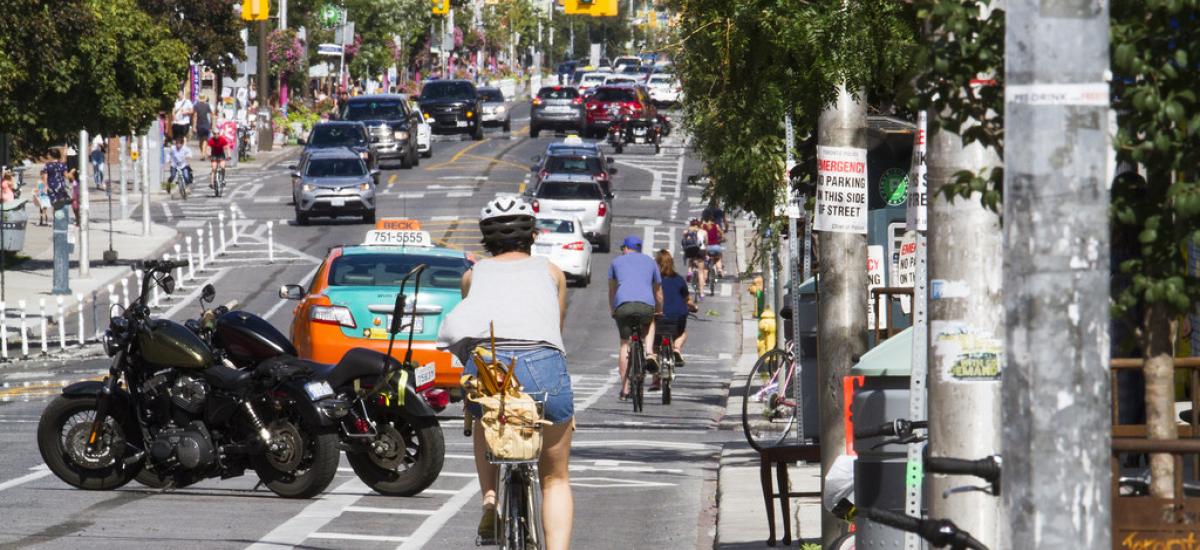One year later: Advocacy in action on Bloor

From idea to pilot
Bike lanes on Bloor St were identified as a key connection in planning documents since the late 1970s. Advocates had called for bike lanes Bloor St ever since. Building on initiatives like Take the Tooker, in late 2013, Cycle Toronto, Bells on Bloor and local residents called for pilot bike lanes on Bloor St. After the 2014 municipal election, we launched a Bloor working group where Cycle Toronto staff could collaborate with local ward volunteers, local councillors Mike Layton and Joe Cressy and other advocacy groups to chart the strategic direction towards getting a pilot project introduced. In Spring 2015, the Bloor Loves Bikes campaign was born.
Over the next year, we took Mayor Tory on a bike ride, to give him a taste of life on a bike on busy Toronto streets. We attended and promoted every City-run open house and survey, breaking the city’s records for number of respondents. We organized dozens of volunteers to survey businesses, and placed Bloor Loves Bikes stickers up in over 90 windows of supportive businesses along the corridor. We organized pub crawls, socials, speaking events and mass rides to spread the word. We had teams of canvassers collect over 10,000 signatures to be to delivered at Toronto City Council. We even built a pop-up bike lane outside Honest Ed’s during Open Streets TO.
Pop-up bike lane on Bloor St at Open Streets TO 2015
In an innovative move, local city councillors Joe Cressy and Mike Layton worked with the Bloor Annex and Koreatown Business Improvement Areas to get their buy-in for an economic impact assessment of the pilot lanes.
Leading up to the vote, we teamed up with campaign partners, like the David Suzuki Foundation and others to get commitment from councillors that they would vote in support of the bike lanes. Hundreds of people wrote and called their local city councillor and the Mayor to tell them just how much they liked bike lanes on Bloor St. The pilot narrowly survived the vote at Public Works & Infrastructure Committee, but won with a landslide at Council after we secured the Mayor’s support.
From pilot to permanence
After the Bloor pilot was installed, the next chapter began. Through a deepened partnership with the David Suzuki Foundation, we hired a full time staff-person to dedicate efforts on our three campaigns, including Yonge and Danforth. We hired a team of part-time canvassers to go door-to-door to build support in key wards, work that was was crucial in opening up lines of communication between constituents and their councillors.
Cycle Toronto’s canvass staff team
But permanent bike lanes on Bloor were not a sure thing. In response to a staff report released in February 2017 describing an 8 minute increase in travel time for motor vehicles during the peak of the peak of rush hour, Public Works Chair Jaye Robinson said that “If the bike lanes were to come to Council today, they wouldn’t have support.”
Campaign volunteers organized the #TourDeBloor, a bike-and-buy passport contest to support local businesses. Outreach teams and canvassers gathered another 9,000 signatures in support of keeping the Bloor pilot. We even bought advertising space on the TTC near City Hall. Hundreds of emails and dozens of calls to the Mayor’s office kept the pressure on.
All the while, City Staff worked tirelessly to produce one of the most comprehensively examined transportation studies in the history of the City of Toronto, supported by peer-reviewed research from Toronto Centre for Active Transportation and the University of Toronto. Released in October 2017, the landmark report found that:
- Cycling volumes on Bloor St had increased to more than 5,000 cyclists per day over a 10 month period,
- Travel times for motor vehicles had been cut in half from the previous staff report
- ‘Near-miss’ collisions for all road users were down by 44%
- Customer counts were up, vacancy rates were stable and Moneris credit card data suggested that sales were up by 4.5% year over year, more than the area of Bloor west of the pilot and the control area on Danforth Avenue.
We helped organize one of the most powerful and diverse set of speakers at the Public Works Committee with more than 50 people and organizations presenting in favour of making Bloor permanent. City Council expressed overwhelming support, with 36 votes in favour of installing the lanes permanently, with only 6 opposed.
From permanence to expansion
This is a milestone to be celebrated, but is also the first small step of many more to come. Councillor Layton and Councillor Cressy were unparalleled champions of this project, and they invested deeply in its success. Mayor Tory’s leadership was also crucial in persuading the rest of council to support the project. It’s clear that local councillor support is vital to expanding Toronto’s Minimum Grid of protected bike lanes.
With the next municipal election in 2018, the priorities that shape our streets will be election issues, and with changes to the status quo, progress can never be taken for granted. The extension of the Bloor St bike lanes and new bike lanes on Danforth, Yonge and beyond are tied to the political outcomes of the upcoming election, and we’re preparing to make sure that these hard fought gains are not undone.
Don’t watch another 40 years go by, invest in cycling advocacy today. If you're not already a member, join our more than 3,000 members now.
